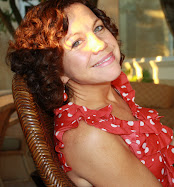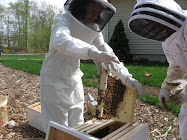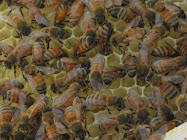Here they are! The first seeds that I have planted for the 2009 season! Exciting. I am going to plant most of my seeds earlier than I did last year. They were tiny little seedlings by the time May came around. One reason may be that it was a bit too chilly for their liking down in our basement. Our basement is finished, but we keep the heat way down unless someone is down there playing. Soooo . . . I'm going to have to try and resolve that somehow.
The first seeds I planted were from the onion family. Last year I planted leeks, starting them from seeds. Although their growing time is very long (100 days +) they were extremely low maintenance. No one wanted to eat them (bugs or rabbits or chipmunks or deer) and they just sat there minding their own business, plodding along. Even if you don't get to picking them -- they just keep on keepin' on during the entire winter. Wow. What a plant! Yesterday I planted: Siegfried Leek (winter hardy), Bandit Leek (winter hardy), Riverside Onion (stores for 5+ months, smaller) and Siskiyou Sweet Onion heirloom (cold hardy to -10 degrees, but not a good storer, large flat 5-7" bulb).
Planting your own seeds is simple! And cheaper than purchasing seedlings. Plus, you will have a lot more variety to choose from when purchasing seeds from seed companies.
- First, buy flats for planting your seeds into. I saved all of mine from last year. With good care they should be able to last you many years. Plain Old Kristi was very resourceful about saving all kinds of containers to plant her seeds into. Check out some of her ideas here.
- Buy seed starting soil. Lighter than potting soil, it's best for seeds. Or you could mix your own by combining potting soil, compost and peat moss or leaf mold. I am hoping to make mine either next year or the year after depending on how my leaf mold compost bin does.
- Buy your seeds. It's not too late! I have been happiest with my seeds from Seeds of Change. Abundant Life Seeds and Johnny Seeds have also been very good. In these catalogs there are a wide selection of vegetables and fruits -- with several different varieties of each kind.
- Fill a bucket with an inch or two of water, dump soil up to the top of the bucket, drizzle a little more water on top and toss. This is a great job for the kids. Ripley was my soil stirrer.
- Fill your containers with soil. (Another job that Ripley did.) Pack the soil down lightly, so that when you go to take your little seedling out, the whole clump wont fall apart. Plus, soil compacts a bit and your seedling will need some soil to sink it's roots into.
- A good rule of thumb, in general, is to plant each seed in a small hold double it's size. So if you have a small onion seed that's just under 1/8" wide, plant it in a hole 1/4" deep. But this information should also be on the back of the seed packet. I made my little holes with a pencil.
- Drop your seeds in the holes and gently cover and pat each seed with soil.
- Plant more seeds that you think you will need. Invariably you will have some fatalities or seeds that just didn't "take". Plus, seedling make great little gifts to friends!
- Cover your seeds with a plastic top, or plastic wrap, or plastic bags (lifted off the soil with Popsicle sticks or twigs) to keep the soil evenly moist. This isn't imperative, but it keeps the maintenance lower (really no need to water in this stage if the top is on).

- Seeds with a hard "shell" on the outside sprout even more reliably with soaking. Soak for 4-8 hours in a little water at room temperature. I have not done this with all of my seeds. But frankly, it's a little bit of a pain. The seeds stick to the bowl, and it's tough to drain the water without losing a few seeds. I had several different types of peppers and tomatoes (the seeds that I soaked) and I had every small custard cup and bowl out trying to keep them separate and their varieties "tagged". This is not necessary, but it is supposed to help your seeds along, particularly more challenging seeds. I'd say, if you are up to it, go for it, if not -- bypass this step.
- Another sure fire way to get your seeds to sprout without worry is to put them on top of a heating pad set on low. This is a miracle worker -- particularly if you live up north and keep your house cool. Many seeds need to be at least 70 degrees in order to germinate (this information should be on the back of the seed packet). I wish my house was 70 degrees! But it's not. Humph.

- Once your seedlings have sprouted, take off the cover and put them in a very sunny window or under a fluorescent light. In our house, we only have one window with southern exposure -- and it's in Ripley's room! So I had to use fluorescent lights. I bought these cheaply at Home Depot last year for something like 9-14$ apiece. It's a one time investment. Not a big deal. The light needs to be lowered to 6" above the seedlings. I have my lights suspended with sturdy string that is looped through hooks that are screwed into the wooden beams in my basement's ceiling.

- The directions on the back of your seed packets will tell you how many weeks before your last frost you should start your seeds indoors. The directions will also tell you if it's best to sow them directly into your garden (root vegetables for example). Some vegetables are very easy to plant outdoors and quick to grow, so they don't merit the effort to start seeds indoors ahead of time. Examples of these are: Beans, Peas, Cucumbers, Squash (summer and winter), and lettuce. Directions on the packet will also tell you when it is safe to transplant the seedlings outside or sow directly into the soil outside. For most vegetables, this will be after the threat of frost has past. However others, like peas, beans, lettuce, and other cold weather greens can be sowed earlier.
- Now, once your seedlings are ready for planting STOP! It is necessary to go through a period called "hardening off". That means that a week before you are ready to plant your seedlings, bring them outside for several hours, then bring them back inside -- for 7 days, give or take. If you don't do this, there is a very good chance that your new seedlings will die in short order. This process builds up the seedlings resistance to wind, colder temperatures, outdoor sunshine, etc., etc.

I hope these directions help -- especially for those of you who are hesitant to grow your own vegetables. It's just not that hard. Start with easy things like lettuce, arugula, kale, beans, tomatoes, cucumbers, squash, herbs such as basil and parsley (only the tomatoes should be started from seed indoors). Or start very simply with ONLY those things you can easily sow directly into the soil. A girlfriend of mine started a small kitchen garden along one side of her house. She had more lettuce, cilantro, cucumbers, tomatoes, and parsley than she knew what to do with. Of course this year she wants to expand! Beware, growing your own food is addictive! And, that's a good thing. :)






























3 comments:
Wow! Awesome. We haven't even ordered our seeds yet, though we are marking up our seed catalog with hi-liters o-plenty. =)
Well, how well do egg cartons compost? I probably have close to 3 dozen. We can't recycle here; I was giving them to a lady with chickens, but haven't heard from her in a while. So guess I might as well let you compost them. :) If you don't want them let me know. Sounds exciting. The girls & I would love to come visit sometime. :)
-Gail
Hey Gail,
Yes, egg cartons compost, and you can also start seeds in them. Sure, bring em on! After the weather turns and there is more than just snow outside, for sure you guys should come on over and check out the garden. Show me how to swing an ax would ya?!
Sandy
Post a Comment